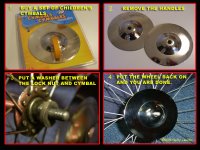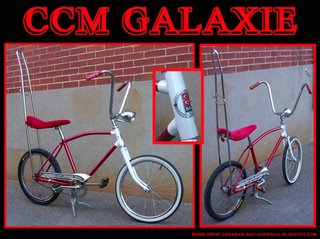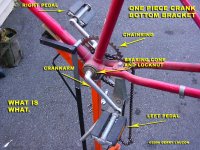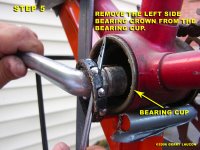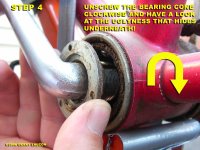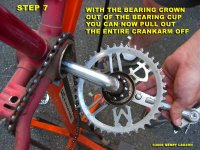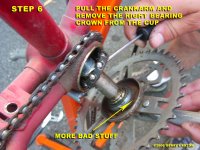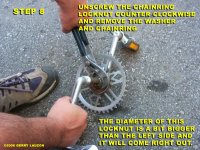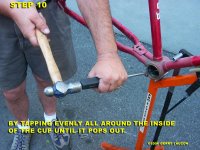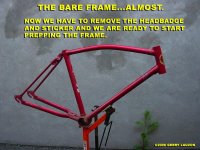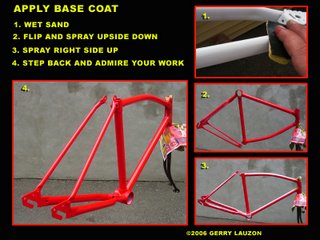
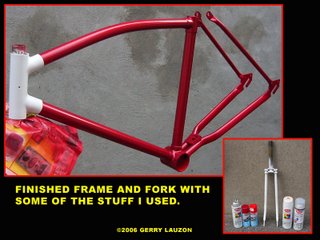 Day 1
Day 1After verifying that the primer was dry, I got on my trusty cruiser bicycle and headed for the closest
Canadian Tire(This is one of the country's landmark stores) for the metallic red paint that I had in mind. I found a small can of auto touch up paint with the color "Rasperry Red" metallic. Cool, it looks almost like a perfect match to the Galaxie's original color. I got back home and prepared my set up, only to find that the can I had purchased was missing it's nozzle. Having no time to waste, I used the nozzle from my base color's can.
Before you start applying any coat of paint, you have to wet sand the primer to smooth out the small rough spots and eliminate overspray. Do this with a 400 grit or finer sandpaper that you immerse in water. You can even put water on the frame while you do this. Now in this case, sanding is a big word. You are applying paint from a rattle can, not a spray gun. The paint layer is pretty thin, so carress that frame with your very wet sand paper, don't rub or you'll go right through that coat in a flash. Feel with your hand between every pass, if it's smooth, stop, that's enough. Wet sanding will have to be done between every coat. Don't forget to clean and dry your frame after doing this. Just use water and a paper towel. Paint doesn't stick to water.
Metallic paints are somewhat translucent. You need to put down a base coat of the color you want to use before the metallic color, or not, it's up to you. I tested this on the fork that holds the bike in the stand. Since it got sprayed with primer at the same time as the frame yesterday, any booboo would come up right away. I also had the chance to look at the difference with and without the base coat on it. With, looked a lot better. So I sprayed the base coat first, which was GM Torch red. I did the same steps as in the primer how to. Paint underneath and the small nooks first. Then flip it over right side up and finish the job. Don't forget to wipe the nozzle every second pass with a rag to avoid paint build up on the nozzle and paint splatter on your surface. I masked the front of the bike frame since I wanted to keep it white. Spend the bucks on good tape and use lots of it. You don't want any other color than the one you have underneath that mask.
Since the base color and the metallic color were both the same type of paint and from the same manufacturer, I went ahead with the metallic coat that afternoon. The frame had been sitting in the blazing sun most of the morning and was dry to the touch. I again wet sanded the whole thing and did the upside down right side up painting routine again. The first coat of metallic took the whole can! It looked great...until it dried and I had a good view of it in the sun. Little mistakes here and there, spots missing paint. Crap! It needs a second coat, can't blame a guy for wishful thinking.
Day 2Went back to the friendly neighbourghood Canadian Tire with the trusty cruiser. Bought another can of Rasperry Red, checked, before paying, that the stupid can came with a nozzle. Went home and started to set up, look at the sky...good, sunny. Wet sand the frame, clean it, apply second coat of metallic. Put the frame in the sun, apply first coat of epoxy clear to the already painted fork, wow! That stuff is amazing, like candy.
Bring the frame into the shed, started to rain. Rain stops, bring frame back out. Now I'm looking at this thing of beauty, it actually came out pretty good and all I want to do is slap on that super
Krylon epoxy clear coat right now...AAAAAAAAArgh! I'll have to wait, even though the color is dry to the touch, I know too well that the process is not over underneath that rasperry shine. I apply another coat of clear to the fork to calm down. Remember, be patient, mistakes happen when we rush things. The clear coat will be applied tomorrow and the result will be awsome I am sure.
Next post, we'll start putting stuff back together. The clear coat will be left to dry for at least 4 days before I touch anything. When paint dries, you must threat it as if it was made of eggshells. New paint always seem to attract scratches when you rebuild. So wait for it to dry good before you handle it.
Til next time, keep your hands dirty.
Gerry


